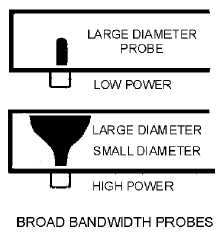1-30
Figure 1-39D.—Probe coupling in a rectangular waveguide.
The most efficient place to locate the probe is in the center of the "a" wall, parallel to the "b" wall,
and one quarter-wavelength from the shorted end of the waveguide, as shown in figure 1-39B, and figure
1-39C. This is the point at which the E field is maximum in the dominant mode. Therefore, energy
transfer (coupling) is maximum at this point. Note that the quarter-wavelength spacing is at the frequency
required to propagate the dominant mode.
In many applications a lesser degree of energy transfer, called loose coupling, is desirable. The
amount of energy transfer can be reduced by decreasing the length of the probe, by moving it out of the
center of the E field, or by shielding it. Where the degree of coupling must be varied frequently, the probe
is made retractable so the length can be easily changed.
The size and shape of the probe determines its frequency, bandwidth, and power-handling capability.
As the diameter of a probe increases, the bandwidth increases. A probe similar in shape to a door knob is
capable of handling much higher power and a larger bandwidth than a conventional probe. The greater
power-handling capability is directly related to the increased surface area. Two examples of
broad-bandwidth probes are illustrated in figure 1-39D. Removal of energy from a waveguide is simply a
reversal of the injection process using the same type of probe.
Another way of injecting energy into a waveguide is by setting up an H field in the waveguide. This
can be accomplished by inserting a small loop which carries a high current into the waveguide, as shown
in figure 1-40A. A magnetic field builds up around the loop and expands to fit the waveguide, as shown
in figure 1-40B. If the frequency of the current in the loop is within the bandwidth of the waveguide,
energy will be transferred to the waveguide.
For the most efficient coupling to the waveguide, the loop is inserted at one of several points where
the magnetic field will be of greatest strength. Four of those points are shown in figure 1-40C.

